Story and photos: David Haring, DLC Registrar and Photographer (retired). Videos: DLC staff, including Endora’s caretaker Jodi Stirk. Published January 18, 2021.
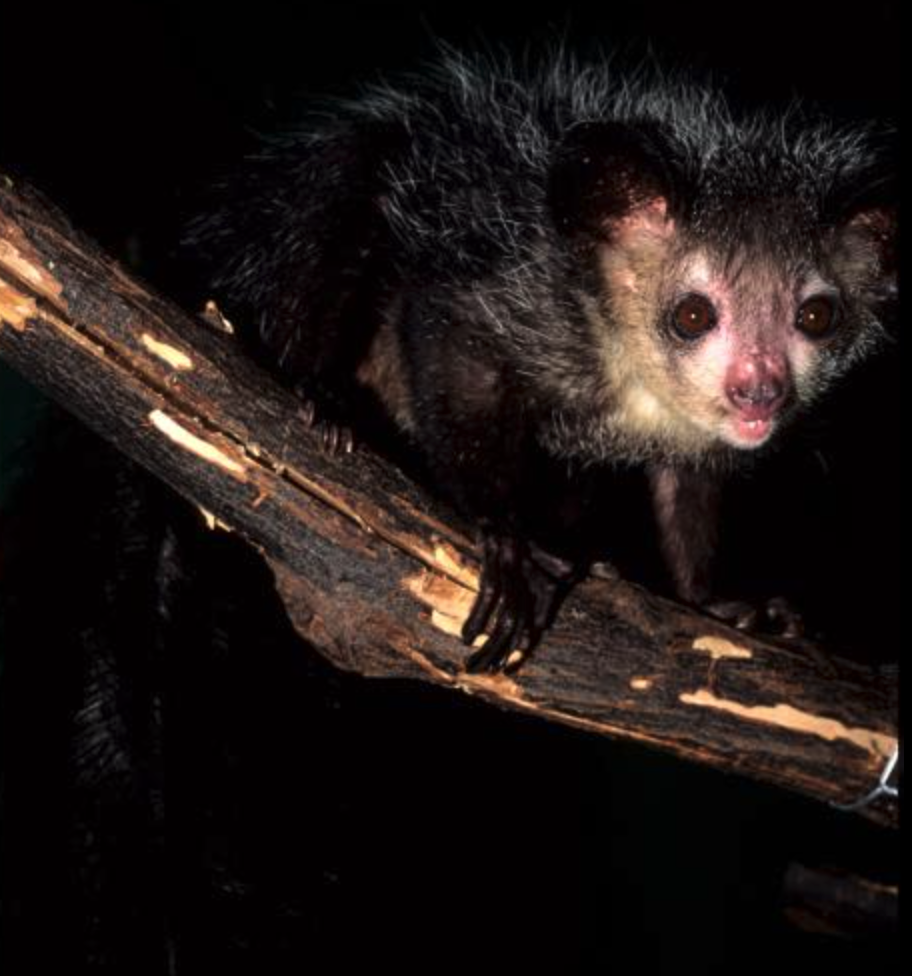
Endora in February 1993. She arrived in Durham in December 1991, along with three other aye-ayes imported from unprotected and severely fragmented forests in Madagascar. Endora lived at the DLC for 29.5 years before passing away on August 26, 2021.
Lemur legend Endora, one of the original eight founders of the Duke Lemur Center’s aye-aye conservation breeding program, and the oldest aye-aye ever to be maintained within human care, died on August 26, 2021 at the age of approximately 37 years.
For three decades, Endora had helped the DLC, as well as individuals and institutions across the globe, in unlocking the secrets of the behavior of lesser-known prosimian species such as the aye-aye.
The DLC’s aye-aye conservation breeding program was launched in the mid-1980s when the DLC (then called the Duke University Primate Center) received USFWS-issued CITES permits to import eight aye-ayes from unprotected and severely fragmented forests in Madagascar. Endora hailed from western Madagascar, near the village of Anjimangirana, and arrived in Durham on December 13, 1991 along with two other females (Ozma and Morticia) and one male (Mephistopheles).
The four cleared quarantine just over a month later, and were given entrance exams by Duke University veterinarians, one of whom made the following comments about Endora’s physical condition: “teeth worn, ears very depigmented, she must be old”! That vet would surely be astonished to learn that Endora, who thrived at the DLC, would live for an additional 29.5 years!
Two previous DLC missions to Madagascar had imported the Center’s first aye-ayes: Poe and Nosferatu (Nosy) in 1987, followed by a mother-daughter pair, Annabelle Lee and Samantha, in 1988.
Read more about the arrival of our first aye-ayes in the article “The DLC’s Founding Aye-aye Fathers (and Mothers)” and in this aye-aye pedigree chart created in 2017.
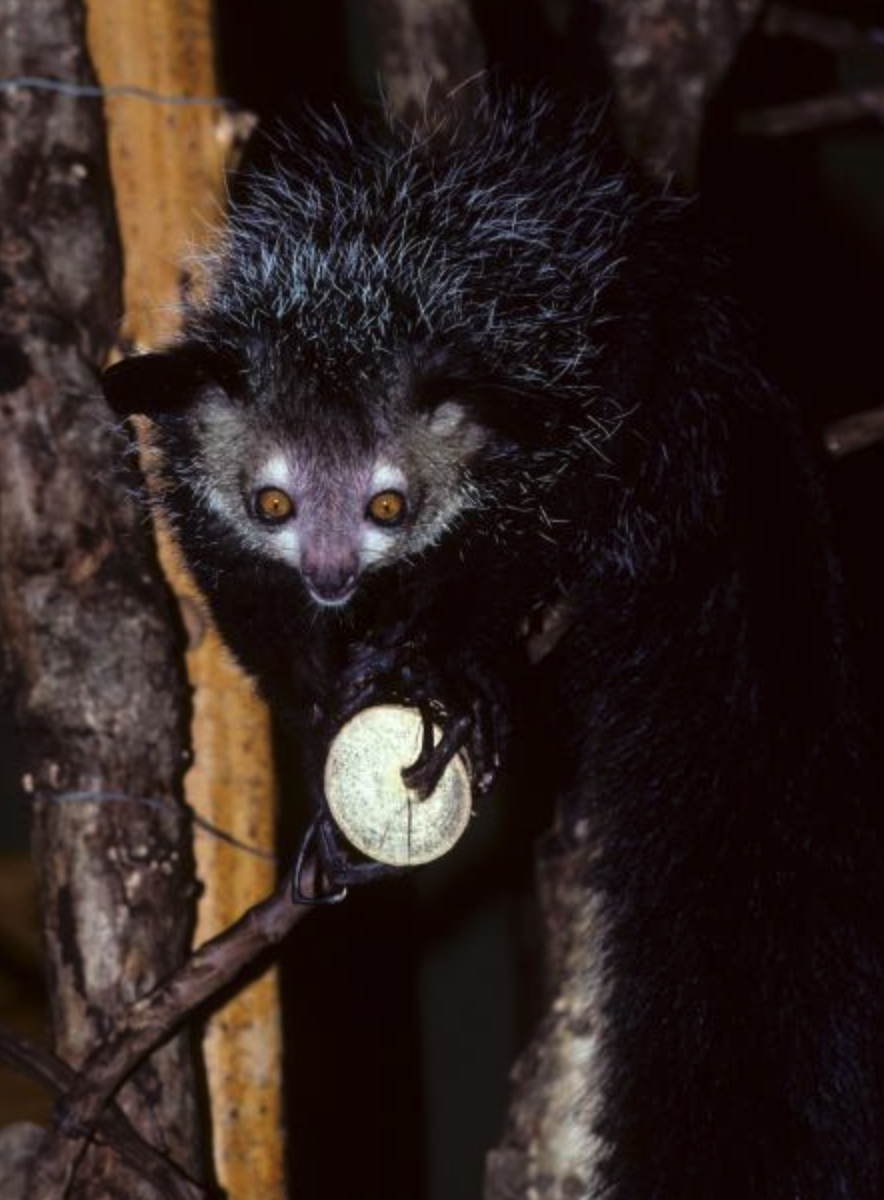
Endora’s long-time mate, Nosferatu (1985-2018), with whom she had five infants. Nosy is pictured here in 1988, one year after his arrival from Madagascar.
Arrival of the first aye-ayes
When Poe and Nosy arrived at the DLC, aye-ayes had never been successfully maintained within human care for significant amounts of time; hence little was known about the animals’ behavior, feeding ecology, and nutritional requirements. It’s truly a testament to the skill of the Lemur Center staff that six of the eight wild-caught aye-aye proved to be so long-lived at the DLC. Mephistopheles died in 2014 at the age of 33, Morticia died in 2016 at the age of 28, Nosferatu died in 2018 at 32, and Ozma died in 2019 at the age of 33. With the passing of Endora, only one wild-caught aye-aye remains at the Lemur Center: Poe, who is approximately 35 years old. In fact, this past New Year’s Eve (2021) marked the 34th anniversary of Poe’s arrival at the Lemur Center!
Because the species had never been maintained successfully within human care, the original wild caught aye-ayes, Poe and Nosy, were trailblazers, helping their human caretakers unravel the mystery of what constituted a basic diet for this species. With the pair’s diligent munching of (or turning their noses up at) novel food items offered, the basic DLC diet was established during those first couple of years and, in fact, this diet continues to be tweaked to this day.
Even after dietary guidelines were successfully in place, many unanswered questions remained about the aye-ayes’ social system. The basic aye-aye family group structure in the wild had not been studied, and no one had any idea of the specifics of the species’ breeding behaviors, gestation length, infant-raising techniques, age at which infants were weaned, and amount of time required before a dam with a newborn infant might breed again. These questions could not be answered for captive animals until the DLC colony held females and an actual breeding program was launched; hence the arrival of Morticia, Ozma, and Endora (along with male Mephistopheles) was perfectly timed, and over the years to follow, the three females provided scientists and DLC animal care staff with an enormous amount of data to help unravel those mysteries.
The Birth of Blue Devil
Endora jumped right into the task at hand of helping us unlock the secrets of aye-aye social systems, and continued to do so for her first couple of decades in residence. Within a month of arriving, Endora was paired with fellow wild-caught aye-aye Nosy. Although the male-female pair did not always live together (adult males are generally removed when infants are born because the protectiveness of the female can make life tough for the submissive males), Endora and Nosy were generally extremely compatible. During their years together, the pair produced six offspring, eight grandchildren, and, so far, one great-grandchild.

Endora’s infant Blue Devil, born in 1992 and pictured here at just a few days old, was the first aye-aye born in North America.
Endora’s first infant born at the DLC (and the first aye-aye to be born in North America), a male named Blue Devil, was discovered unexpectedly in his mother’s nest by technician Bill Hess in April 1992—only four months after she was brought to the U.S. She had been pregnant by a wild male when she arrived from Madagascar.
As Hess cleaned Endora’s room that day, he was completely taken aback by the sound of rustling coming from what he thought was her unoccupied nestbox. One natural history fact DLC staff did know about wild aye-ayes was that they build sleeping nests constructed from twigs and leaves in the tops of trees. From the day they arrived at the DLC, all aye-ayes were provided with nestboxes. Inside these basic wooden boxes some adults would construct much more elaborate nests fashioned from materials (leaves, twigs, blankets) provided by their keepers.
Any infants living inside these elaborate structures constructed by their dams were essentially hidden from sight, and unless humans intervened, newborn infants would not be seen for two or three months until they ventured out on their own. With the birth of Blue Devil, DLC staff quickly realized that the only way an infant’s growth and development could be monitored was by regular weighings. To assure that infants were growing at a satisfactory rate and were healthy, they had to be hand-grabbed by a keeper who, once or twice a week, reached deeply into the nest, felt for the infant, and then after gently grasping it, quickly pulled it out of the nest, with the mother (and her large teeth and incredibly powerful jaw) just a few inches away!
Luckily, Endora, and later the other aye-aye dams, proved to be surprisingly tolerant of this process, especially if they were given a peanut or some similar treat as a bribe! But it was important that the procedure take place during “daylight” hours (when the nocturnal aye-aye’s rooms were illuminated by bright white lights and the animals were sleeping). The infant weighing wouldn’t work during nighttime hours, when rooms were darkened and the adults were active—because, even though dams might be away from their nests, they tended to respond much more quickly to any threats to their infants, and might aggressively defend them.
Five additional infants born
After the birth of Blue Devil, Endora continued to behave as if she were totally on board with the goals of the DLC aye-aye breeding program. In June 1994, Endora gave birth to another male, Merlin, her first infant conceived at the Lemur Center (with, of course, the ever-reliable Nosferatu).
As aye-ayes were known to be solitary in the wild, with infants leaving their natal groups naturally at sexual maturity, Blue Devil had been given his own enclosure away from Endora at 1.5 years of age. At the time, this was a normal age for lemur infants of most species to be pulled from their natal group, but as DLC staff were to discover, aye-ayes are by no means “most species.” Although Blue Devil seemed to be perfectly healthy, new data generated by Endora and the other breeding females in the following years provided previously unknown information about aye-aye reproduction. While most lemur infants are fully weaned at 4-6 months, aye-aye infants continue to nurse for at least a year after birth, and in some instances, females were seen to be still lactating 2.5 years after the birth of an infant! Removing Blue Devil from Endora apparently did encourage her to cycle, however, and around three months later she came into estrus, and she and Nosferatu successfully conceived Merlin.
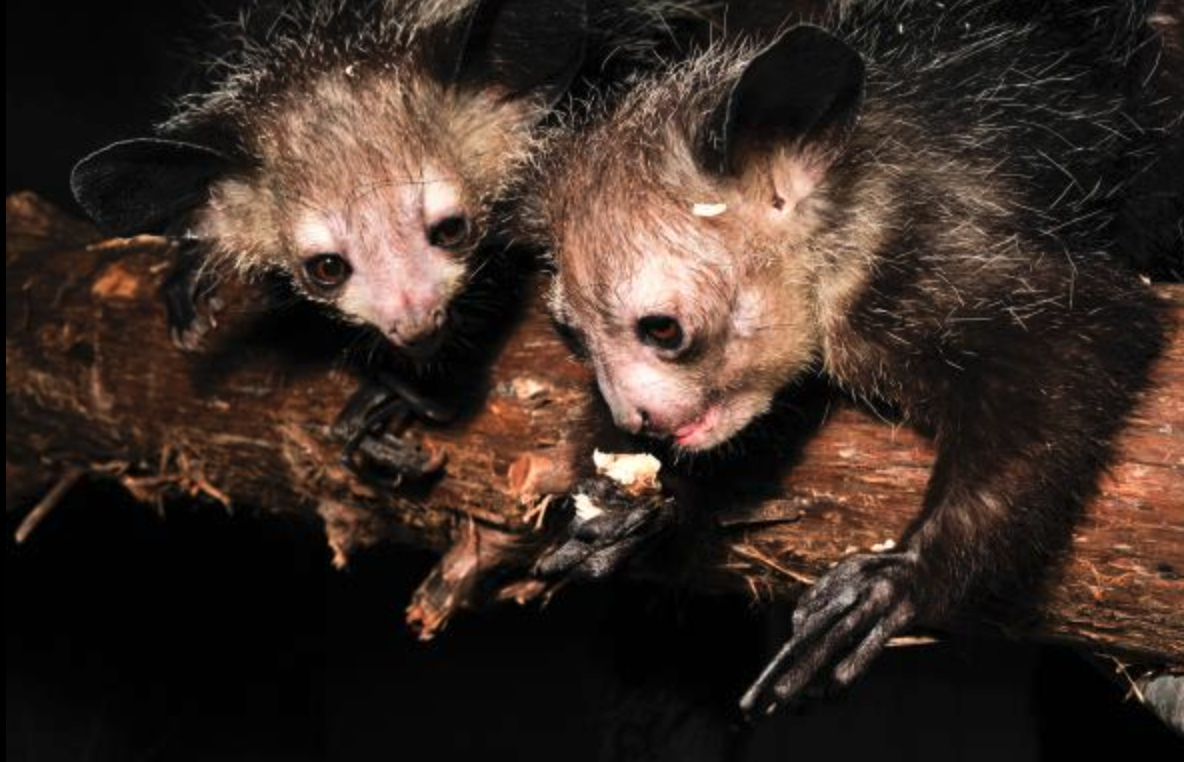
Endora’s daughter Kali with granddaughter Bellatrix in 2010. Endora raised six infants: Blue Devil (sired by a wild male) and Merlin, Kali, Lucrezia, Claudia, and Grendel (all sired by Nosferatu).
Merlin lived with Endora and, occasionally, with Nosferatu, until he was three years of age and was housed apart from his dam. Endora and Nosferatu bred soon after Merlin’s departure, and Endora’s first female infant, Kali, was born in January 1998. During this period, it was apparent that Endora was at the peak of her DLC breeding years, and it seemed as if an approximately three-year interbirth interval for her might be optimal. Sure enough, three years and one month later Endora and Nosferatu bred again, while the now young adult Kali was still living with her mom.
When Endora’s second female infant, Lucrezia, was born in July 2001, the keeper who discovered the infant in the nestbox at an early morning check was surprised to see that Kali was also present in the box! A perhaps even greater surprise was the fact that 3.5-year-old Kali was also (along with the infant) nursing on Endora! Kali had been fully weaned for a long time, so she was just taking advantage of Endora’s suddenly abundant milk supply. This situation, if allowed to continue, would obviously have put a huge metabolic demand on the 18.5-year-old Endora; thus Kali was removed from her dam. DLC staff had originally thought that allowing Kali to continue to live with her dam and new baby sister might provide her with a valuable opportunity to gain first-hand experience in aye-aye infant care, as, in general, it seems like the more experience that a young lemur (especially females) can get watching how their dams take care of a new infant, the better. Unfortunately, this was not an option.
With Kali out of the picture, it was thought this might be a good opportunity to experiment with allowing an aye-aye sire to continue to live with his mate and newborn offspring, and this was attempted here, but with mixed results. Nosferatu seemed stressed to be living with Endora and the newborn Lucrezia, so the decision was made to remove him from the group and simply monitor Endora for estrus and introduce Nosferatu back whenever she was at the peak of her cycle. Over the years this strategy of keeping males and females separated and introducing them only when females were in estrus became one of the main tools for managing aye-aye breeding. Designated breeding pairs would be set up in side-by-side rooms connected by a small passageway that could be closed off via a sliding door (through which pairs would have some visual and olfactory access) until such time as the female was cycling. At that point, the sliding door would be opened for a few hours or a few days until breeding was (hopefully) completed.
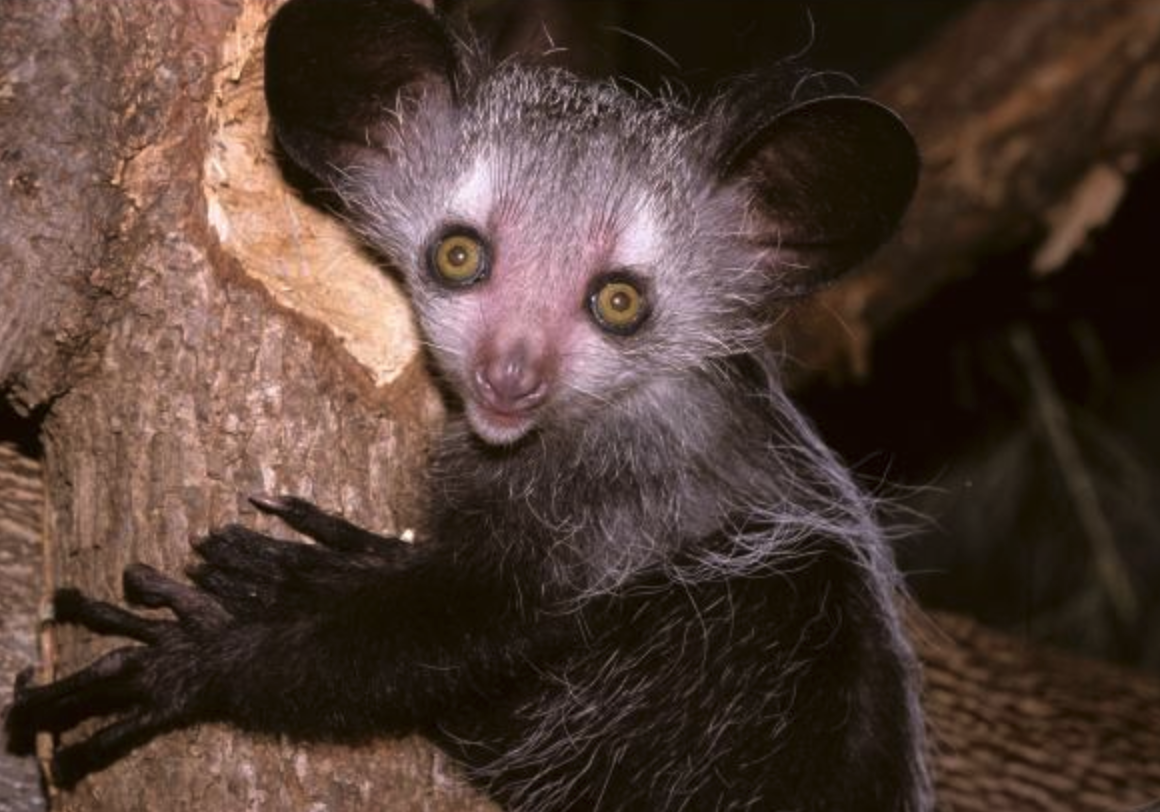
Lucrezia, pictured here at three months old, was born to Endora in 2001.
Lucrezia and Endora lived together for four years until Lucrezia’s was housed separately in July 2005. During this time, life began to change for Endora. In 2004, she began experiencing dental problems that would plague her for the remainder of her life, and generally her health began a slow and steady decline. She also started to get a bit cranky both with Nosferatu and with her keepers.
When Lucrezia was two, Endora started to cycle again for the first time since her daughter’s birth. From May 2003 until July 2005 when Lucrezia was removed from her mom, there were seven additional introductions of Nosferatu to Endora (with Lucrezia present) with hopes that the pair would breed, but they never did. Finally Lucrezia (now four) was removed and Nosferatu could now be introduced permanently to Endora without fear of being harassed by the bold Lucrezia. By this time staff concluded that Endora was post reproductive. An entry in animal records for the pair’s introduction on 13 July 2005 read “Endora moved to 019D for introduction to Nosferatu. They will be kept together overnight and perhaps permanently. He was interested in her, but kept his distance, she ignored him. This move is not for breeding (Endora is too old probably) but for companionship and her well-being.”
Apparently Endora had other ideas as to what constituted her well-being, and although no breeding was observed between her and Nosferatu, to everyone’s surprise several months later in October she was palpated pregnant! Although she might have been spry for her 22 years, Endora could also exhibit the crankiness of an older lemur and a few weeks later poor Nosferatu had to be moved out of the room he shared with Endora because she was “chasing him without mercy”. A month after this incident, on 30 December 2005, Endora was discovered with her third female infant, Claudia. Nosferatu and Endora had apparently bred shortly after Lucrezia had been moved and the old couple had been reunited.
Claudia thrived under Endora’s care and, like nearly all of her infants, she was out of sight of the Lemur Center staff (except during her weighings) until she made her public debut by exiting the nestbox and starting to explore the room when she was about two months old. Claudia lived with Endora for three years and ten months until she was removed for pairing with another aye-aye.
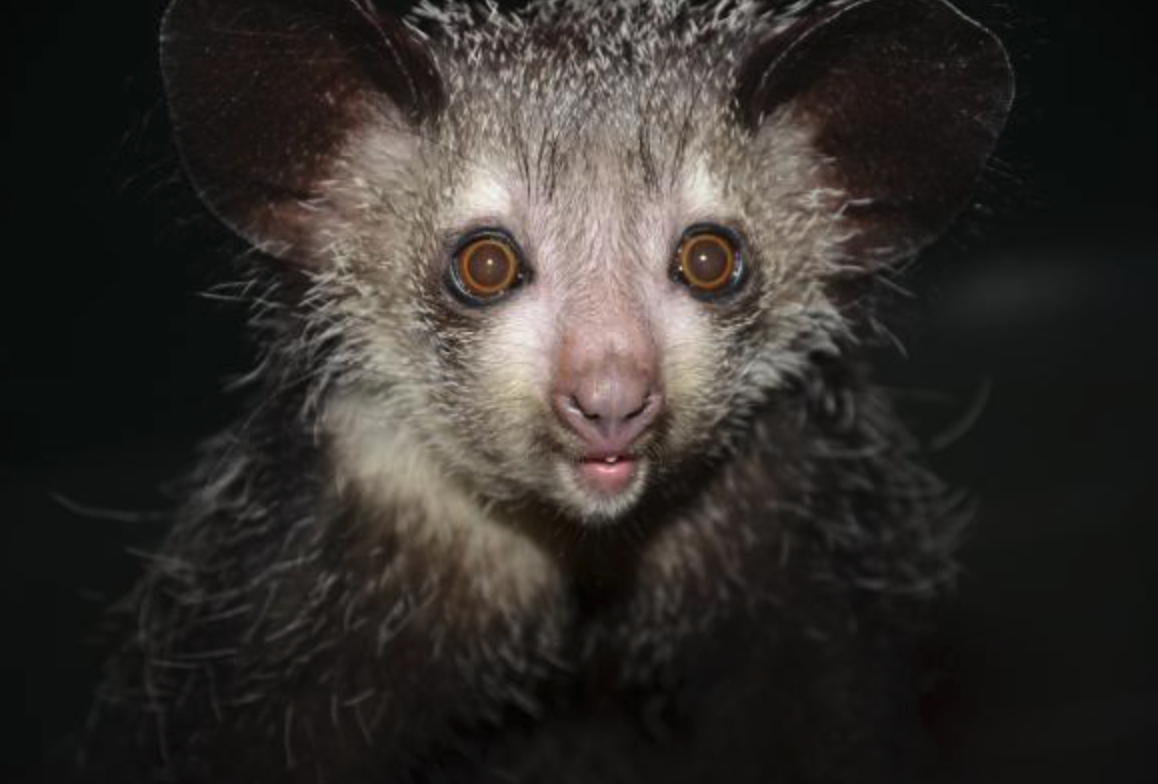
Endora’s sixth and final infant, Grendel, born in 2010 and pictured here in 2013.
Endora gave birth for the final time on May 23, 2010 to her sixth infant, a male named Grendel. Like all her infants, Grendel thrived from birth. Endora, however, struggled for a while after giving birth to Grendel, and exhibited clear signs that her body might soon be unable to cope with the demands of gestation/lactation. Grendel lived with Endora until he was a little over five years old.
After Grendel was moved to his own enclosure, DLC management once again (10 years after their initial announcement) decreed that Endora was now truly post-reproductive and it was time for her to retire from the demands of infant raising.
With her total of six amazingly healthy infants, Endora made a huge contribution to the aye-aye captive breeding program. In addition to the 18 infants produced by the three wild-caught females, their contributions to the previously poorly understood areas of captive husbandry and even the natural history of aye-ayes was enormous.

Endora celebrates her 35th birthday with a special banana-and-raisin “cupcake” from her keeper team.
Retirement
Although Morticia died in 2016, Ozma was still alive and well when Endora was retired from breeding. Attempts to house unrelated adult female aye-ayes together had never been made, but in an effort to provide both Endora (32) and Ozma (30) with valuable companionship, the two were introduced over a period of several weeks in January 2016.
Jodi Stirk, who began caring for Endora right after she was separated from Grendel and was involved in the introduction of the two “old ladies,” felt that “both Endora and Ozma benefited from living together. They were more active, and I felt that their appetites improved when they lived together. Sharing the space certainly made their environment more stimulating. Occasionally I found the girls sleeping together in a nestbox, but for the most part each minded her own business. Endora spent her time on the floor and Ozma spent her time on the structure and branches.”
The elderly aye-ayes lived together, mostly peacefully, for over three years, but, sadly, Ozma died May 3, 2019. With Endora alone, and with no suitable companions available, Jodi and other DLC technicians ramped up the amount of attention and enrichment being provided to Endora, and without doubt those efforts made a huge difference in the quality of life experienced by Endora in her final years.
The paragraphs below, which were written by Jodi after Endora’s passing, eloquently describe the level of care provided to Endora her final years and the genuine affection all DLC technicians display towards their charges, especially the geriatric lemurs.
“Toward the end of her life, I discovered her love for nesting in small or odd-shaped cardboard boxes. Endora preferred to nest on the floor rather than on the raised platforms. It took a while to discover the perfect nesting combo of materials for her to nest with, but by the end I had it down. She loved wood wool and packing paper the most, and she would take them from where I placed them in the room into her box. During the summer months she also enjoyed nesting with lespedeza, small pieces of sweetgum, tulip poplar, and other types of browse. It was not uncommon for her to poke her head out of her nest in the morning during white light while staff were cleaning her room. It was a nice way to start the day with her popping out to say hi before going back into her nest if you had nothing to offer her.
“One of my favorite things about Endora was this hilarious sound she made whenever she had a type of enrichment with honey (Endora LOVED honey and that was always my go-to item if I needed to encourage her to take certain medications), nut butter, or syrups on it and she was really into eating it. She made this snorting noise while licking it up off the enrichment. I made sure to give her enrichment to encourage that sound on my last day working with her. I knew it would be something I would miss most about her.”

